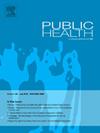生活方式在心血管代谢疾病进展中的作用:一项回顾性队列研究
IF 3.2
3区 医学
Q1 PUBLIC, ENVIRONMENTAL & OCCUPATIONAL HEALTH
引用次数: 0
摘要
目的探讨生活方式因素(LFs)对从无心血管代谢疾病(CMD)到首发CMD,再到心血管代谢多病(CMM),再到死亡的影响。研究设计回顾性队列研究。方法数据来源于新郑市电子健康管理中心居民年度健康体检数据库。共有100,231名年龄≥40岁、基线时无2型糖尿病(T2DM)、缺血性心脏病(IHD)和卒中的参与者入组。CMM定义为T2DM、IHD和卒中中≥2种疾病。我们使用多状态模型来探讨LFs(吸烟、饮酒、饮食习惯、身体活动和体型)在CMD进展的不同阶段的影响。结果在平均4.19年的随访期间,47272名参与者至少发展为一种CMD, 10734名参与者发展为CMM, 13378名参与者随后死亡。从无CMD到第一次CMD和从第一次CMD到CMM的每个额外高风险生活方式因素的风险比(95%置信区间)分别为1.44(1.43-1.46)和1.14(1.12,1.17),而从无CMD、第一次CMD和CMM过渡的死亡风险比分别为1.16(0.92,1.46)、1.12(1.06,1.17)和1.25(1.20,1.30)。当第一次慢性阻塞性肺病进一步细分为T2DM、IHD和卒中时,我们发现即使在相同的过渡阶段,五种高风险LFs对疾病特异性过渡的影响也不同。结论我们的研究结果强调了将综合生活方式干预纳入中老年CMD管理的重要性。本文章由计算机程序翻译,如有差异,请以英文原文为准。
The role of lifestyle in the progression of cardiometabolic disease: A retrospective cohort study
Objectives
We aimed to explore the impact of lifestyle factors (LFs) on the transition from no cardiometabolic disease (CMD) to first CMD, subsequently to cardiometabolic multimorbidity (CMM), and then to death.
Study design
Retrospective cohort study.
Methods
The data from the annual health checkup database for residents of the Electronic Health Management Center in Xinzheng, China. A total of 100,231 participants aged ≥40 years who were free of type 2 diabetes mellitus (T2DM), ischemic heart disease (IHD), and stroke at baseline were enrolled. CMM was defined as ≥2 diseases of T2DM, IHD, and stroke. We used multi-state models to explore the impact of LFs (smoking, drinking, dietary habits, physical activity, and body size) in different stages of CMD progression.
Results
During a mean follow-up of 4.19 years, 47272 participants developed at least one CMD, 10734 developed CMM, and 13378 died afterward. The hazard ratios (95 % confidence intervals) for each additional high-risk lifestyle factor for transitions from no CMD to first CMD and from first CMD to CMM were 1.44 (1.43–1.46) and 1.14 (1.12,1.17), while those for the risk of death for transitions from no CMD, first CMD, and CMM were 1.16 (0.92,1.46), 1.12 (1.06,1.17) and 1.25 (1.20,1.30). When first CMDs were further subdivided into T2DM, IHD, and stroke, we found that even at the same transition stage, the five high-risk LFs had different impacts on disease-specific transitions.
Conclusions
Our findings emphasize the importance of incorporating comprehensive lifestyle interventions into the management of CMD in middle-aged and older adults.
求助全文
通过发布文献求助,成功后即可免费获取论文全文。
去求助
来源期刊

Public Health
医学-公共卫生、环境卫生与职业卫生
CiteScore
7.60
自引率
0.00%
发文量
280
审稿时长
37 days
期刊介绍:
Public Health is an international, multidisciplinary peer-reviewed journal. It publishes original papers, reviews and short reports on all aspects of the science, philosophy, and practice of public health.
 求助内容:
求助内容: 应助结果提醒方式:
应助结果提醒方式:


